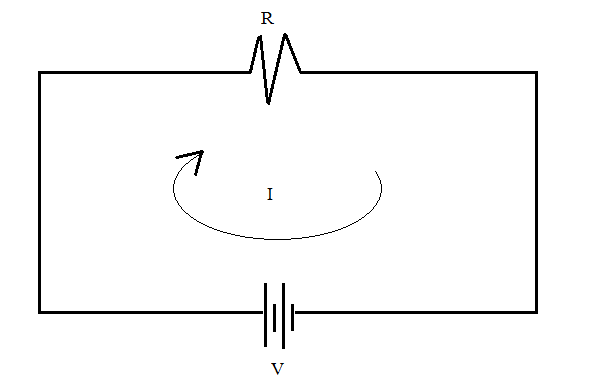
Draw a circuit diagram to verify ohm’s law.
Answer
570.9k+ views
Hint: In this question, we need to verify the ohm's law by sketching a circuit diagram. For this, we will follow Kirchhoff's voltage law.
Complete step by step answer:Let us consider a circuit in which a resistance “R” is connected with a DC voltage source, “V”.

As the circuit is closed, a current of magnitude “I” flows in the circuit.
According to Kirchhoff’s voltage law, the sum of the voltage drop across all the elements attached in the closed-circuit is arithmetical equals to zero.
So, in the above figure, there is a voltage source of magnitude “V”. There will be the voltage drop which will be equivalent to the product of the current flowing through the resistance and the magnitude of the resistance. Mathematically, ${V_r} = IR$ where “I” is the current flowing through the resistance “R” and ${V_r}$ is the potential drop across the resistance.
Now, applying Kirchhoff’s voltage law, we get
$
V - IR = 0 \\
V = IR \\
$
The above equation can also be written as:
$\dfrac{V}{I} = R$
Here, “R” is the constant value which is fixed and will not change with time and the voltage source connected across it. Hence, we can write $\dfrac{V}{I} = R$ as:
$\dfrac{V}{I} = {\text{constant}}$
The above equation can again be re-written as:
$V \propto I$
This is the basic statement and the mathematical expression for the ohm’s law which states that the voltage in a closed circuit is directly proportional to the current associated with the circuit only.
Note:Students must know about the Kirchhoff’s voltage law to establish the ohm’s law. Moreover, it is interesting to note here that the ohm’s law is not valid for the semiconductor devices.
Complete step by step answer:Let us consider a circuit in which a resistance “R” is connected with a DC voltage source, “V”.

As the circuit is closed, a current of magnitude “I” flows in the circuit.
According to Kirchhoff’s voltage law, the sum of the voltage drop across all the elements attached in the closed-circuit is arithmetical equals to zero.
So, in the above figure, there is a voltage source of magnitude “V”. There will be the voltage drop which will be equivalent to the product of the current flowing through the resistance and the magnitude of the resistance. Mathematically, ${V_r} = IR$ where “I” is the current flowing through the resistance “R” and ${V_r}$ is the potential drop across the resistance.
Now, applying Kirchhoff’s voltage law, we get
$
V - IR = 0 \\
V = IR \\
$
The above equation can also be written as:
$\dfrac{V}{I} = R$
Here, “R” is the constant value which is fixed and will not change with time and the voltage source connected across it. Hence, we can write $\dfrac{V}{I} = R$ as:
$\dfrac{V}{I} = {\text{constant}}$
The above equation can again be re-written as:
$V \propto I$
This is the basic statement and the mathematical expression for the ohm’s law which states that the voltage in a closed circuit is directly proportional to the current associated with the circuit only.
Note:Students must know about the Kirchhoff’s voltage law to establish the ohm’s law. Moreover, it is interesting to note here that the ohm’s law is not valid for the semiconductor devices.
Recently Updated Pages
Master Class 12 Business Studies: Engaging Questions & Answers for Success

Master Class 12 Economics: Engaging Questions & Answers for Success

Master Class 12 English: Engaging Questions & Answers for Success

Master Class 12 Maths: Engaging Questions & Answers for Success

Master Class 12 Social Science: Engaging Questions & Answers for Success

Master Class 12 Chemistry: Engaging Questions & Answers for Success

Trending doubts
What are the major means of transport Explain each class 12 social science CBSE

Which are the Top 10 Largest Countries of the World?

Draw a labelled sketch of the human eye class 12 physics CBSE

Explain sex determination in humans with line diag class 12 biology CBSE

The pH of the pancreatic juice is A 64 B 86 C 120 D class 12 biology CBSE

Give 10 examples of unisexual and bisexual flowers




